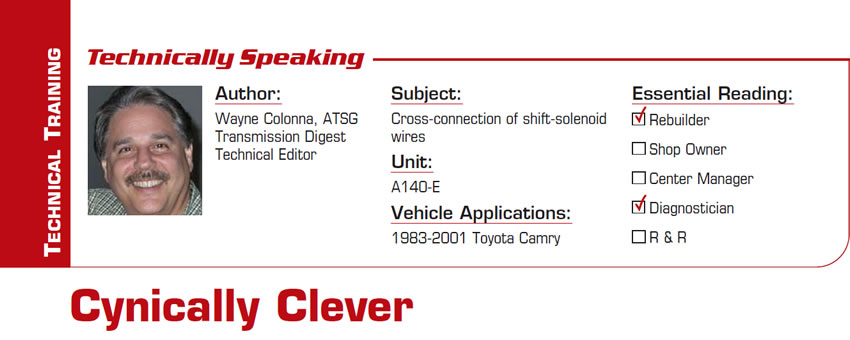
Technically Speaking
- Subject: Cross-connection of shift-solenoid wires
- Unit: A140-E
- Vehicle Application: 1983-2001 Toyota Camry
- Essential Reading: Rebuilder, Diagnostician
- Author: Wayne Colonna, ATSG, Transmission Digest Technical Editor
Last month I made some comments regarding the Cash for Clunkers program that I must say, by the time the magazine went to print, were already partially outdated. Interesting enough, our tech lines at ATSG are experiencing an increase in calls with what would be considered “outdated” or older vehicles. I recently handled a call with a vehicle old enough to have a 325-4L transmission in it. I didn’t think there were still any running around, so it made me wonder whether it had been garaged and because of our times was now out for repairs.
There is a shop I get to play around in when I am not traveling on the weekends doing seminars for ATSG. I have seen with my own eyes an increase in older vehicles coming in for repairs. Figure 1 looks like something you would have seen in the late ’80s or early ’90s, yet I took this picture myself on Aug. 8. Where were they all this time? They apparently have been hanging around in garages across the country and are now coming out for repairs.

With the same being true in other shops across the country, what I have noticed from our tech lines is that either some of what we learned back in the late ’80s and early ’90s has been forgotten or there are a few new builders who have never worked on some of these older units.
One recent example involved a Toyota Camry with the A140-E four-speed transaxle and an L4 engine. Although this transmission was used in model years 1983 through 2001, we rarely receive calls on it – yet in one week I had three calls. One problem was rapid or stacked upshifts with no kick-down shifts. This problem is typically caused by restricted solenoids. The second call was a harsh engagement into reverse. This is typically caused by the use of flat frictions to replace the waved ones originally installed (see Shift Pointers on page XX of this issue).
The call on the third problem went like this: “It feels like a stuck governor but I know it doesn’t have a governor. I say that because it feels like I am taking off in a higher gear but it then shifts to a lower gear. And then, if I am not getting into the throttle too hard it seems like it goes to an even lower gear; otherwise, it suddenly neutralizes.”
At this point in the conversation I already know what the problem is because of numerous experiences taking calls on these units. Not only do I know what the problem is but I also can predict the response I will receive once I explain the problem. This is how it always seems to go: “The problem is that the solenoids are cross-connected so the transmission is now taking off in third, shifts to second, then goes to first, and if you could drive it fast enough it could go to fourth” (figures 2 and 3).

The response will be: “That can’t be. One of the wires for the solenoid is too short, so you can’t cross-connect the solenoid” (Figure 4).

And then I say: “You are right only if you route the wiring past that valve body correctly. But when you run the harness past the valve body incorrectly, the solenoids get cross-connected” (figures 5, 6, 7 and 8).


Usually I can sense doubt about what I am saying at the other end of the phone, so I go on to say: “Drop the pan (Figure 9) and look at the wire colors. Does the white wire (Figure 10) go to the solenoid pointing to the front bumper or is it the black wire? If it is the black wire it is cross-connected; if it is the white wire, you have it right and I am wrong.”


Seldom will I get a phone call back to thank me for telling them that they had the wires cross-connected and the problem was now solved. With this particular phone call that I recently had, the pan was already down and it was immediately confirmed that the solenoids were cross-connected.
But I have to tell you, there was one occasion when I took a call about this problem and the technician insisted he had not cross-connected the solenoids. He was adamant about it, because he had made this mistake once so he knew about it. I asked him whether he had some kind of shift box that would allow him to manually operate the solenoids himself, and he did. And wouldn’t you know it, the transmission shifted perfectly. This verified that internally he had everything wired right. But once the vehicle harness was connected to the transmission it shifted 3-2-1-4. This brought us to the TCM, where just when you thought you had seen it all the two shift-solenoid wires had been cut and swapped near the connector.
Apparently someone had worked on this transmission years earlier and had cross-connected the solenoids. Rather than dropping the pan and valve body to correct the problem, they decided to swap the wires at the TCM. When it came to this shop for repairs, the technician connected the wires to the solenoids properly only to have them malfunction as if he had cross-connected the solenoids. Whoever swapped those solenoid wires at the TCM, I can only say that he or she was cynically clever. What a kick in the pants.
It goes to show that even when you’re working on the simpler, older vehicles, if you have forgotten their idiosyncrasies or are too young to know their idiosyncrasies, they could still give you a bit of a challenge, especially if a cynically clever person went before you.














